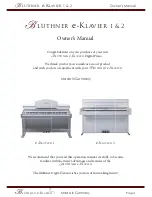
INTRODUCTION
TURBIDITY
What is Turbidity?
Turbidity is an aggregate property of the solution, water in most cases. Turbidity is not
specific to the types of particles in the water. They could be suspended or colloidal
matter and they can be inorganic, organic or biological. At high concentrations
turbidity is perceived as cloudiness or haze or an absence of clarity in the water.
Turbidity is an optical property that results when light passing through a liquid sample
is scattered. The scattering of light results in a change in the direction of the light
passing through the liquid. This is most often caused when the light strikes particles in
solution and is scattered backward, sideways and forward. If the turbidity is low much
of the light will continue in the original direction. Light scattered by the particles allows
the particle to be ”seen” or detected in solution. Just as sunlight passing through a
window is a scattered by dust particles in the air, allowing them to be seen.
In the past 10 years, turbidity has become more than just a measure of water clarity.
Because of the emergence of pathogens such as Cryptosporidium and Giardia,
turbidity now holds the key to assuring proper water filtration. In 1998, the EPA
published the IESWTR (interim enhanced surface water treatment rule) mandating
turbidities in combined filter effluent to read at or below 0.3 NTU. By doing so, the
EPA hoped to achieve a 2 log (99%) removal of Cryptosporidium. There is presently
consideration to lower this to 0.1 NTU. The trend has been to check the calibration of
on-line turbidimeters with hand-held field units. The optical design and low detection
limit of the 2020 allow very accurate readings for such calibrations.
The meter also allows the user to choose the units of measure for expressing turbidity.
While nephelometric turbidity unit (NTU) has been the standard for years, FNU
(formazin nephelometric unit) and FAU (formazin attenuation unit) are now being used
in ISO 7027 units. American Society of Brewing Chemists (ASBC) units and European
Brewery Convention (EBC) units allow the brewing industry to check process waters.
How is Turbidity Measured?
Turbidity is measured by detecting and quantifying the scattering of light in water
(solution). Turbidity can be measured in many ways. There are visual methods and
instrumental methods. Visual methods are more suitable for samples with high
turbidity. Instrumental methods can be used on samples with both high and low levels
of turbidity.
Two visual methods are the Secchi Disk method and the Jackson Candle method. The
Secchi Disk method is often used in natural waters. A black and white Secchi Disk is
lowered into the water until it can no longer be seen. It is then raised until it can be
seen again. The average of these two distances is known as the “Secchi Depth”. The
Jackson Candle method uses a long glass tube over a standard candle. Water is
added or removed from the tube until the candle flame becomes indistinct. The depth
of the water measured with a calibrated scale is reported as Jackson Turbidity Units
(JTU). The lowest turbidity that can be determined with this method is about 25 NTU.
There are two common methods for instruments to measure turbidity. Instruments can
measure the attenuation of a light beam passing through a sample and they can
measure the scattered light from a light beam passing through a sample. In the
attenuation method, the intensity of a light beam passing through turbid sample is
6
INTRODUCTION
Summary of Contents for 2020e
Page 1: ...2020e Code 1979 EPA 2020i Code 1979 ISO Version 1 5 Code 1979 MN 12 07 e i...
Page 2: ......
Page 43: ......







































